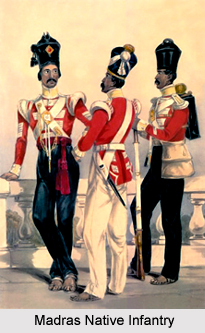 The 7th Madras Native Infantry was an infantry battalion of the British East India Company, which existed from the year 1759 to 1922. It was a part of the Madras Native Infantry under the Madras Army, before the beginning of the Sepoy Mutiny, also known as the Indian Rebellion of 1857. The military regiment was also included as a part of the Madras Command. The Madras Army was the armed forces of Madras Presidency and was established with the purpose of protecting the commercial interests of the British East India Company. It was amongst the 3 main Presidency Armies in British India. After the Government of India Act 1858 was authorized following the Sepoy Mutiny in 1857, the authority of the 3 Presidency Armies was transferred to the British Empire in India from the British East India Company. Consequently the British Empire took charge over the British East India Company and the 3 British Presidency Armies, namely the Madras Army, the Bengal Army and the Bombay Army. The 7th Madras Native Light Infantry was also known as the 67th Punjabis Regiment.
The 7th Madras Native Infantry was an infantry battalion of the British East India Company, which existed from the year 1759 to 1922. It was a part of the Madras Native Infantry under the Madras Army, before the beginning of the Sepoy Mutiny, also known as the Indian Rebellion of 1857. The military regiment was also included as a part of the Madras Command. The Madras Army was the armed forces of Madras Presidency and was established with the purpose of protecting the commercial interests of the British East India Company. It was amongst the 3 main Presidency Armies in British India. After the Government of India Act 1858 was authorized following the Sepoy Mutiny in 1857, the authority of the 3 Presidency Armies was transferred to the British Empire in India from the British East India Company. Consequently the British Empire took charge over the British East India Company and the 3 British Presidency Armies, namely the Madras Army, the Bengal Army and the Bombay Army. The 7th Madras Native Light Infantry was also known as the 67th Punjabis Regiment.
History of 7th Madras Native Infantry
The 7th Madras Native Infantry was formed in the year 1759 as the 8th Battalion Coast Sepoys. The military unit first functioned in the Carnatic Wars and later provided service in the Third Anglo Mysore War. During the First World War, the regiment was at first in the 4th (Quetta) Division in 1914. This unit served as a training unit and performed duties on internal security in British India during this period. Subsequently a 2nd battalion was raised and both the companies were stationed abroad.
Operations of 7th Madras Native Infantry
The regiment served in the 12th Indian Division and took part in the Battle of Khafajiya, the Battle of Shaiba and the Battle of Nasiriya during the Campaign to Mesopotamia. The battalion later participated in the Carnatic Wars and also the Third Anglo Mysore War. The second battalion of the 67th Punjabis Regiment, along with the 14th Indian Division, also participated in the operation in Mesopotamia. The army unit took part in the Second Battle of Kut and was involved in the collapse of Baghdad in the year 1917. Later both the battalions of the 7th Madras Native Light Infantry fought in the Third Anglo Afghan War.
Development of 7th Madras Native Infantry
The British Government of India renumbered and re-organised the regiments of the British Indian army after the culmination of the First World War. The separate single battalion infantry regiments were united together in order to develop multi battalion regiments. Due to these reforms, the 67th Punjabis regiment was re-designated as the 1st and 10th (Training) Battalions, 2nd Punjab Regiment in 1922.
After the country gained independence from the rule of the British Empire in India in the year 1947, the nation was segregated through the Partition of India into the Union of India and the Dominion of Pakistan. The British Indian Army was divided amongst the 2 newly independent nations. The 7th Madras Native Infantry regiment was assigned to the modern Indian Army.
Designations of 7th Madras Native Infantry
The 67th Punjabis of the British Indian Army occupied many titles through out its service during the restructuring of the army, like all the other regiments. These are listed as follows-
* 8th Battalion Coast Sepoys (1759)
* 8th Carnatic Battalion (1769)
* 7th Carnatic Battalion (1770)
* 7th Madras Battalion (1784)
* 1st Battalion, 7th Madras Native Infantry (1796)
* 7th Madras Native Infantry (1824)
* 7th Madras Infantry (1885)
* 67th Punjabis (1903)






































